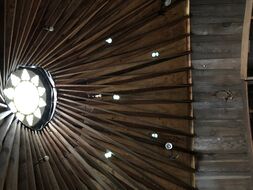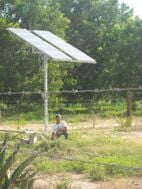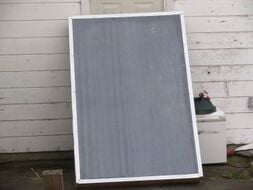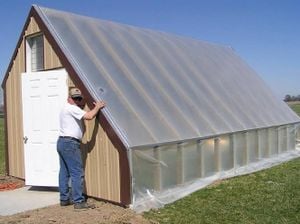
Passive solar design is the harnessing or directing of solar energy through non-mechanical, non-electrical means. It is a key principle of green building, often applied in designing buildings for maximum solar heating during cold winter months and maximum protection from the sun's heat during hot summer months. Passive solar is distinguished from active solar by the lack of operable devices.
There are 6 main types of passive solar design.[1] These can be considered in 3 generic categories in terms of the relationship between the thermal collector (or dissipator) and the interior space of the structure.[2] These categories are direct gain, indirect gain and isolated systems. Within each category, there are 2 distinct approaches.[2]
Direct gain[edit | edit source]
Direct gain is a type of passive solar heating system that uses direct solar radiation to heat a building. In these systems, thermal transfer occurs within the building interior and it may either be distrubeted throughout the building (e.g. the floors and the pole facing walls), or mass may be concentrated..[2]
Buildings using a direct gain system use large, south-facing windows to admit sunlight. However, using a direct gain system requires that a structure uses thermal storage material to absorb the radiation. A failure to do so will result in inside temperatures rising to more than 90deg F.
Indirect gain[edit | edit source]
In indirect gain systems, thermal transfer takes place at the building envelope.[2]The 2 types of indirect gain system are the thermal wall or trombe wall and the roof pond.[2]
Trombe wall[edit | edit source]
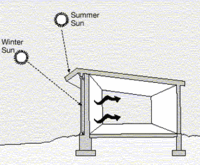
A Trombe wall is a sun-facing wall used in passive solar design. Patented in 1881 by its inventor, Edward Morse, and popularized in 1964 by French engineer Félix Trombe and architect Jacques Michel. It is a massive wall separated from the outdoors by glazing and an air space, which absorbs solar energy and releases it selectively towards the interior at night.
Even single-pane glass works for this process, because glass is transparent to visible light, but less so to infra-red radiation (heat). Modern variations include insulating glass to retain more of the stored solar heat and high and low — sometimes operable — vents to allow convective heat transfer to the indoors.
Isolated systems[edit | edit source]
The 2 approaches of isolated systems are the sunspace and the thermosyphon.[2]
Thermosyphon[edit | edit source]
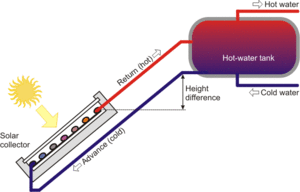
Thermosiphoning, also known as thermosyphoning, is considered to be an appropriate technology. This process utilizes natural, renewable resources and the basic laws of thermodynamics to create movement of a heated supply of air or water. The energy source for this process is solar radiation (or any other source of heat). The energy of the sun is captured in a solar collection device and is transferred to either air or water via conduction. The entire process may be explained by the thermosiphoning effect: when air or water is heated, it gains kinetic energy from the heating source and becomes excited. As a result, the water becomes less dense, expands, and thus rises. In contrast, when water or air is cooled, energy is extracted from the molecules and the water becomes less active, more dense, and tends to "sink." Thermosiphoning harnesses the natural density differences between cold and hot fluids, and controls them in a system that produces natural fluid movement. Several systems based on this technology are currently available, and may be read about in greater detail within the following text.
The principle of the thermosyphon system is that cold water has a higher specific gravity (density) than warm water, and so being heavier will sink down. Therefore, the collector is always mounted below the water storage tank, so that cold water from the tank reaches the collector via a descending water pipe. If the collector heats up the water, the water rises again and reaches the tank through an ascending water pipe at the upper end of the collector. The cycle of tank → water pipe → collector ensures the water is heated up until it achieves an equilibrium temperature. The consumer can then make use of the hot water from the top of the tank, with any water used is replaced by cold water at the bottom. The collector then heats up the cold water again. Due to higher temperature differences at higher solar irradiances, warm water rises faster than it does at lower irradiances. Therefore, the circulation of water adapts itself almost perfectly to the level of solar irradiance. A thermosyphon system's storage tank must be positioned well above the collector, otherwise the cycle can run backwards during the night and all the water will cool down. Furthermore, the cycle does not work properly at very small height differences. In regions with high solar irradiation and flatroof architecture, storage tanks are usually installed on the roof.
Thermosyphon systems operate very economically as domestic water heating systems. The principle is simple, needing neither a pump nor a control. However, thermosyphon systems are usually not suitable for large systems, that is, those with more than 10 m² of collector surface. Furthermore, it is difficult to place the tank above the collector in buildings with sloping roofs, and single-circuit thermosyphon systems are only suitable for frost-free regions.
Key design techniques[edit | edit source]
Key building design techniques include:
- Planting deciduous trees or trellises covered in deciduous or annual vines. This may be as a fence or as a shade roof, and provides shade in summer and light and warmth in winter.
- Designing and building components with consideration for the seasonal change in the sun's position in the sky, and the influence this will have on the angle and intensity of light hitting the structure. Examples of this include:
- Broad eaves, which block sunlight from entering windows during the summer, but allows it to enter during the winter when the sun is lower in the sky.
- Shade walls (less common): A wall or fence beyond the limits of the house, to provide shade. The wall runs east-west, on the east and/or west side of the house, and is on the north side of the house in the northern hemisphere, and on the south side in the southern hemisphere (i.e., away from the equator). The angle and placement are calculated to shield the house from early morning or late afternoon sun in summer but not in winter. However, this requires significant resources and, unless there are other reasons for a wall, it is generally better to use other methods, such as deciduous trees, or an awning, especially where there are large windows.
- Thermal mass: A critical component of any passive solar design. Its purpose is to absorb and re-radiate heat energy. This has the effect of averaging out the daily extremes of high and low temperature. Thermal mass generally falls into two categories, passive and active. Passive thermal mass heat-storage systems include:
- Thick masonry walls and floors
- Phase-change materials: These materials change phase (typically from solid to liquid) when heated, storing a great deal of heat energy without a corresponding change in temperature. Examples include various high-tech concrete additives and also natural resins, such as those found in Southern Yellow Pine.
- Large liquid storage tanks inside the space to be heated (or cooled)
- Pipes to transfer heat between air and the thermal mass (e.g., in the ground under the house, either with natural convection or with a quiet low-power fan)
- White roofs
- Dark roofs absorb large amounts of solar energy, which transfers into the building. This increase in absorbed heat requires increased electrical energy to remove and cool buildings, homes, and workplaces and maintain a comfortable environment. Dark colors also radiate heat more easily in cold conditions, meaning greater heat loss from buildings and higher heating costs.
- White surfaces have an increased albedo or "whiteness," which is the reflectivity of a surface. If a roof is more reflective less energy will be absorbed and transferred to the building.
- Solar closets
- A shallow glass-fronted closet, lined with dark material, becomes very hot when exposed to the sun. One-way valves (which might be as simple as plastic sheet over wire mesh) allow cool air to enter at the bottom and hot air to exit at the top. They can be used for heating hot water, as well as for space heating.
- When these measures are appropriately utilized and combined the energy efficiency of a building can be much higher than with more conventional design measures.
Passive solar vs passive house[edit | edit source]
The terms passive solar design and passive house are often confused. The two terms refer to green building techniques and are closely related.[3]
Passive solar design is about making best use of available natural light and heat. Heat from the sun is collected (if heating is desired, i.e. in a cool climate). A major part of passive solar design is careful orientation with respect to the sun.[3]Passive House design is about managing heat loss and heat gain (not just from the sun but from all sources). The intended result is to have a structure that requires minimal energy to heat and cool.[3]As such, some state that passive house design has greater applicability than solar design since orientation with respect to the sun is not absolutely necessary. Passive House design does not necessarily require a structure which is elongated along the east-west axis with extensive glazing on the equator facing side. Indeed, the ideal form of a passive house is a cube (lower surface area to volume ratio).[3]Passive solar houses are also said to be more complicated to design, and the internal temperature may fluctuate uncomfortably if they are designed poorly.[4] Proponents of superinsulation state that compared to solar houses, greater savings can be obtained by building air tight with lots of insulation in walls and high R windows.[4]So, while some consider that the debate between passive solar and superinsulation resulted in the wider acceptance of superinsulation,[4]a more efficient approach would potentially be to utilise both passive solar and passive house design elements, which has been termed "Solar Passivhaus".[3]The remainder of this article therefore deals with passive solar in the modern sense of the term which is overlapping that of passive house design (rather than the original passive solar concepts in the 70s and 80s).
Passive annual heat storage[edit | edit source]
Passive Annual Heat Storage (PAHS) is a building concept theorized to create a year-round constant temperature in an earth shelter by means of passive solar heating and a thermal battery effect lasting several months. It is claimed that an earth shelter designed according to PAHS principles would store the Sun's heat in the summer and release it slowly over the winter months without need for other forms of heating. This method was first described by inventor John Hait in his 1983 book.[5]
Related projects[edit | edit source]
See also[edit | edit source]
External links[edit | edit source]
- Passive Solar Design (MP3 audio file). Clear and basic explanation from the OurCoolHouse Podcast
References[edit | edit source]
- ↑ Passive Solar Architecture Pocket Reference. Ken Haggard, David A. Bainbridge, Rachel Aljilani. International Solar Energy Society / Routledge, 2016
- ↑ 2.0 2.1 2.2 2.3 2.4 2.5 Passive Solar Architecture: Heating, Cooling, Ventilation, Daylighting and More Using Natural Flows. D Bainbridge, K Haggard. Chelsea Green Publishing, 2011
- ↑ 3.0 3.1 3.2 3.3 3.4 Passive Solar Architecture Pocket Reference. D Thorpe. Earthscan from Routledge, 2018
- ↑ 4.0 4.1 4.2 Solar Versus Superinsulation: A 30-Year-Old Debate. Martin Holladay. Green Building Advisor, 2010
- ↑ Passive annual heat storage: Improving the design of earth shelters. John Hait. 2013
